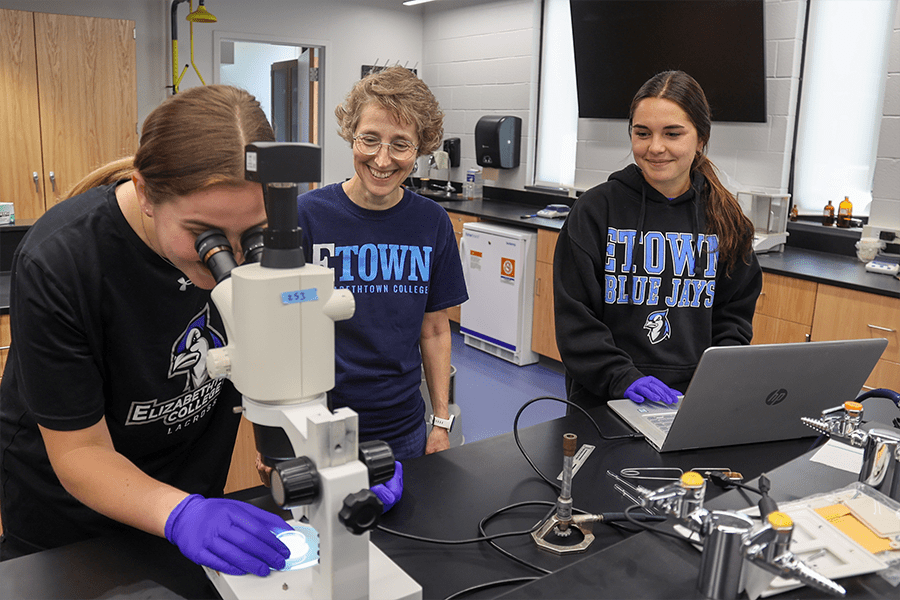Biology majors Mia Cudmore ’25 and Alayna Trynosky ’25 are researching to better understand how C. elegans, a transparent nematode (worm) that feeds on microbes such as bacteria, both develops and is influenced by their environment as part of the Summer Creative Arts and Research Program (SCARP).
Cudmore and Trynosky are working closely with faculty mentor and Professor of Biology Debra Wohl to measure the C. elegans at different growth stages as well as the number of eggs they lay every day. The Blue Jays then separate the C. elegans based on age groups, placing them in various environments to see how they develop over time. Studying C. elegans has important, future research implications as the model system can be used to better understand the indirect impact that antibiotics have on gut microbiome in humans to potentially reduce the negative impacts.
Title of Research
Establishing a C. Elegans Model System to Expand our Understanding of the Gut Microbiome
Student Researchers
Mia Cudmore ’25 and Alayna Trynosky ’25 (Biology majors with a concentration in Health Professions)
Faculty Mentor
Debra Wohl, Professor of Biology

What are you researching?
Cudmore: We are looking at how C. elegans can be a model organism for future experiments, specifically working with their gut microbiome. We have been testing procedures and methods from other research to work with C. elegans and gain a basic understanding of how they grow and reproduce. This will allow us to measure certain aspects of them after modification. Once we can modify conditions, we hope to learn more about their gut microbiome through different testing.
Why did you choose this topic?
Cudmore: This past year, I have been involved in research and wanted to work with a model organism to study the gut microbiome. I believe this is an exciting and important topic for research to be conducted on. Dr. Wohl suggested the model organism could be C. elegans, so I was lucky to be able to work closely with them for SCARP.
Trynosky: I have always wanted to be involved in research on campus to gain experience for my future in addition to gaining an understanding of a new topic. When presented with this topic, I felt like it was the perfect opportunity to learn about an organism that was new to me and do meaningful research. Working to set up the nematodes as a model organism creates many opportunities for future experiments, with the gut microbiome being of interest to me.
What was the most interesting aspect of this research?
Cudmore: The most interesting aspect has been working and learning about the nematodes. We only know what to expect from previous research articles, so to see them grow and reproduce has been exciting.
Trynosky: The most interesting aspect of this research is working through different protocols to see what works for us since it is a new organism to us all. It is rewarding to see new C. elegans grow every day and know we are headed in the right direction.
Talk about working with your mentor. How have they helped you throughout this experience?
Cudmore: Dr. Wohl has been a great resource who has been actively helping us every step of the way with the new organisms in the department. We are all learning how to work with them, and it has been great to be working with a mentor who has been able to provide knowledge and support throughout this learning process.
Trynosky: Dr. Wohl has been a great mentor throughout this whole process. When I was first presented with this opportunity, the excitement surrounding the research was clear. She is always offering tips in the laboratory while also giving my peer and I room to learn on our own. Whenever we have questions she is always willing to help and shares in the excitement about trying new protocols and the results they show.
Hear from the faculty mentor — Debra Wohl
“Working with students and sharing the fun of research is always great. I am so happy to have the opportunity to work with Mia and Alayna this summer. These two can run with an idea. They both have a very positive outlook and are resourceful.”

